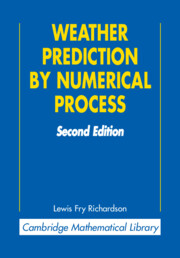Book contents
- Frontmatter
- FOREWORD
- Contents
- PREFACE
- GUIDING SIGNS
- CHAP. I SUMMARY
- CHAP. II INTRODUCTORY EXAMPLE
- CHAP. III THE CHOICE OF COORDINATE DIFFERENCES
- CHAP. IV THE FUNDAMENTAL EQUATIONS
- CHAP. V FINDING THE VERTICAL VELOCITY
- CHAP. VI SPECIAL TREATMENT FOR THE STRATOSPHERE
- CHAP. VII THE ARRANGEMENT OF POINTS AND INSTANTS
- CHAP. VIII REVIEW OF OPERATIONS IN SEQUENCE
- CHAP. IX AN EXAMPLE WORKED ON COMPUTING FORMS
- CHAP. X SMOOTHING THE INITIAL DATA
- CHAP. XI SOME REMAINING PROBLEMS
- CHAP. XII UNITS AND NOTATION
- INDEX OF PERSONS
- INDEX OF SUBSIDIARY SUBJECTS
CHAP. XII - UNITS AND NOTATION
Published online by Cambridge University Press: 06 July 2010
- Frontmatter
- FOREWORD
- Contents
- PREFACE
- GUIDING SIGNS
- CHAP. I SUMMARY
- CHAP. II INTRODUCTORY EXAMPLE
- CHAP. III THE CHOICE OF COORDINATE DIFFERENCES
- CHAP. IV THE FUNDAMENTAL EQUATIONS
- CHAP. V FINDING THE VERTICAL VELOCITY
- CHAP. VI SPECIAL TREATMENT FOR THE STRATOSPHERE
- CHAP. VII THE ARRANGEMENT OF POINTS AND INSTANTS
- CHAP. VIII REVIEW OF OPERATIONS IN SEQUENCE
- CHAP. IX AN EXAMPLE WORKED ON COMPUTING FORMS
- CHAP. X SMOOTHING THE INITIAL DATA
- CHAP. XI SOME REMAINING PROBLEMS
- CHAP. XII UNITS AND NOTATION
- INDEX OF PERSONS
- INDEX OF SUBSIDIARY SUBJECTS
Summary
UNITS
Except where otherwise stated, centimetre-gram-second units are employed. Temperatures are in degrees absolute centigrade. Energy, whether by itself or as involved in entropy or in specific heat, is expressed not in calories but in ergs. A power of ten standing at the beginning of a row or column of figures, and followed by a multiplication sign, is intended to multiply each number in the row or column.
LIST OF SYMBOLS
The following list shows the meanings which have been used throughout the book. Where the symbol requires an extended definition reference is made to the place where the definition will be found.
Mathematical notation is international, so that a foreigner, who is unable to read the letterpress, may yet grasp the purport of the book if he knows the meanings of the symbols only. So here I should like to explain the symbols in “the second language for all mankind”, if there were such a one. Unfortunately there are several rivals, each apparently easier to learn than any national language. Thus there are Esperanto, Ido, Esperantido, all much alike, and differing considerably from Interlingua.
A comparative study of these languages is being made by a committee of the International Research Council (at Washington, U.S.A.) and the choice of one language should rest with some supremely authoritative body.
- Type
- Chapter
- Information
- Weather Prediction by Numerical Process , pp. 223 - 229Publisher: Cambridge University PressPrint publication year: 2007

